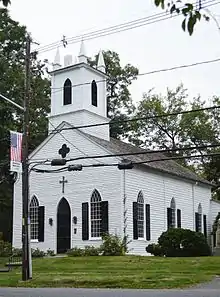Christ Church (Middletown, New Jersey)
Christ Church is a historic church in Middletown Township, New Jersey built in 1744.
| Christ Church | |
|---|---|
| Christ Episcopal Church | |
 | |
 Christ Church | |
| 40°23′38″N 74°07′04″W | |
| Location | Middletown Township, New Jersey |
| Country | United States |
| Denomination | Episcopal |
| Churchmanship | Anglican Communion |
| Website | christchurchmiddletown |
| History | |
| Status | Church |
| Founded | 17 October 1702[1] |
| Dedicated | 1738[1] |
| Events | Sir Henry Clinton and Lord Cornwallis leaving the Battle of Monmouth meet at the Church corner. Some of the wounded were housed in the Church.[1] |
| Architecture | |
| Functional status | Active |
| Style | Neo-gothic |
| Years built | 1744-1745 |
| Groundbreaking | 1744 |
| Completed | 1745 |
| Specifications | |
| Length | 53 feet (16 m)[1] |
| Width | 40.25 feet (12.27 m)[1] |
| Height | 16.5 feet (5.0 m)[1] |
| Materials | Large, hand-shaped rough stone[1] |
| Bells | 1 |
| Administration | |
| Episcopal area | Episcopal Church in the United States of America[2] |
| Diocese | Episcopal Diocese of New Jersey[2] |
| Province | Province II[2] |
| Clergy | |
| Bishop(s) | Rt. Rev. William "Chip" Stokes[3] |
| Rector | Rev. Michael Way http://christchurchmiddletown.org/welcome/clergy |
| Assistant priest(s) | Rev. Dr. Cathy Bickerton[4] |
| Laity | |
| Organist(s) | John Balme |
| Churchwarden(s) | Barbara Garrity and Paul Dawson http://christchurchmiddletown.org/welcome/vestry |
| Parish administrator | Christine Ruland[4] |
Christ Episcopal Church | |
| Location | Middletown Township, New Jersey |
| Built | 1744 |
| Architectural style | Neo-gothic[1] |
| NRHP reference No. | 71000511[1] |
| NJRHP No. | 2022[5] |
| Significant dates | |
| Designated | November 12, 1971 |
| Designated NJRHP | July 19, 1971 |
History
Early years
Though not officially named as such, it is believed that the first Church of England services held in Middletown was in the private home of Alexander Innes, the former chaplain of the Fort of New York, as early as the 1680s. Middletown, at the time, wasn't the best place in the region due to its proximity to the shore and the perpetuation of its residents to house visiting pirates.[1]
In 1701, New Jersey British Governor Lewis Morris wrote to the Bishop of London about the "wicked" Middletown. The letter described the Sunday Meetings (presumably church services) at the local publick house being filled with fights and running of races.[6] By 1702 the Society for the Propagation of the Gospel in Foreign Parts arrived by way of their missionary George Keith. Along with Innes, the men formed what was to become Christ Church on October 17, 1702. For several years, services were held in private homes until 1705, when Judge John Johnson - a friend of Innes - gave over the rights to the old Monmouth Patent courts for use of a church.[1]
In 1738, King George II granted the church an official charter that was signed by Governor William Burnet. By 1744, a building was constructed and finished the next year allowing services to being.[1]
American Revolution
The church survived the battles unscathed despite its proximity to several battles and skirmishes. Following the Battle of Monmouth, the battle-beaten Sir Henry Clinton and Lord Cornwallis met at the church and some of the wounded were held in the Church.[1]
Following the successful end of the War, the Church sent delegated to the first General Convention of the Protestant Episcopal Church in the United States.[1]
Pirates and the church
In 1736, William Leeds, a reputed cohort of the pirate Captain Kidd, had left a sizable glebe for the church. But the controversy over how the glebe came to be is what made the donation a topic of controversy.[6]
Leeds, following a successful career as a pirate and profiteer, had settled, along with some of his fellow shipmates, in the Ideal Beach section of Middletown and married some of the township women. In order for him to make good after his deeds as a pirate, he set up a trust that would be given to both the Middletown and Shrewsbury Christ Churches following his death. The trust included any money and his property at Swimming River, in Leedsville (now Lincroft).[6]
Is it believed that his sizable wealth came, most likely, as a result of is plundering since Leeds was a Society of Friends member and took no part in any piratical violence. Leeds died in 1739.[6]
References
- "National Register of Historic Places Nomination Form - Christ Church". National Park Service. United States Department of the Interior. Retrieved 2 February 2015.
- "Find A Church". The Episcopal Church. Retrieved 3 February 2015.
- "New Jersey". The Episcopal Church. Retrieved 3 February 2015.
- "Clergy & Staff". Christ Church of Middletown. Retrieved 3 February 2015.
- "New Jersey and National Registers of Historic Places" (PDF). NJ DEP - Historic Preservation Office. State of New Jersey. Archived from the original (PDF) on 16 October 2014. Retrieved 24 January 2015.
- DeNicola, Linda (25 February 2012). "The Truth About Christ Church: A Legacy of Piracy in Middletown". Middletown Patch. Patch Media. Retrieved 13 February 2015.
